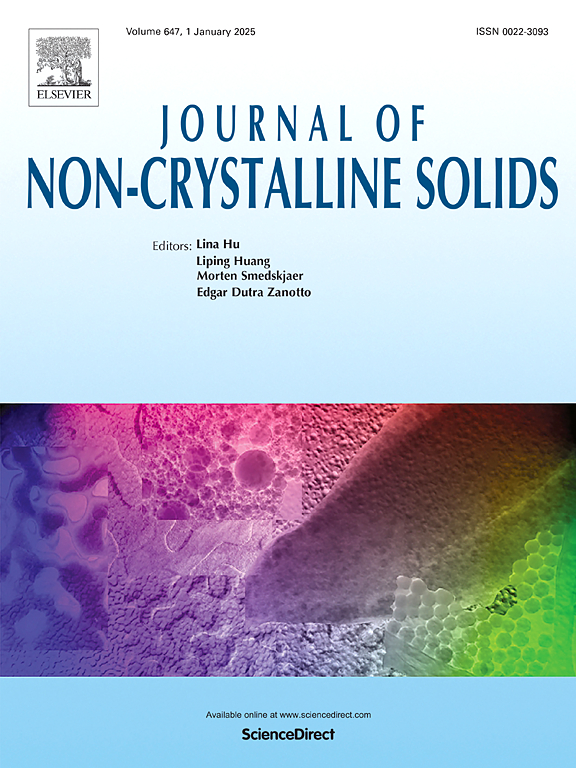Effect of Si/B ratio of low dielectric glass on its structure, properties and sealing mechanism for high-frequency communication
IF 3.5
3区 材料科学
Q1 MATERIALS SCIENCE, CERAMICS
引用次数: 0
Abstract
Sealing glasses are widely used in the electronics industry to provide electrical insulation and form connectors with a range of metals. In this study, a range of SiO2–B2O3–Al2O3–R2O sealing glasses with low dielectric constant and low dielectric loss were prepared using conventional melting and quenching techniques, followed by powder processing. The effects of the SiO2/B2O3 (Si/B) molar ratio on the structure, properties, and sealing mechanism of the glasses were investigated. The results indicated that the network structure of the glass system initially became more compact and subsequently relaxed with an increase in the Si/B ratio. The dielectric constant of the sealing glasses increased with increasing Si/B ratio, whereas the coefficient of thermal expansion and dielectric loss exhibited an initial decrease, followed by an increase. Optimal structural compactness was observed at a Si/B ratio of 2.76, resulting in a lower dielectric constant (4.04@10 GHz) and the lowest dielectric loss (12×10−4@10 GHz). Following sealing, the chemical bonds in the metal surface layer gradually shifted from metallic to ionic–covalent bonds, which facilitated a robust glass–metal bond. These sealing glasses are well suited for RF connector applications and hold promising market potential in the realm of high-frequency communication.
低介电玻璃Si/B比对其结构、性能及高频通信密封机理的影响
密封玻璃广泛应用于电子行业,提供电气绝缘,并与各种金属形成连接器。本研究采用常规熔融淬火工艺制备了低介电常数、低介电损耗的SiO2-B2O3-Al2O3-R2O密封玻璃,并进行了粉末加工。研究了SiO2/B2O3 (Si/B)摩尔比对玻璃结构、性能和密封机理的影响。结果表明,随着Si/B比的增加,玻璃体系的网络结构开始变得更加致密,随后松弛。随着Si/B比的增大,密封玻璃的介电常数增大,热膨胀系数和介电损耗均呈现先减小后增大的趋势。当Si/B比为2.76时,结构紧凑性最佳,介电常数较低(4.04@10 GHz),介电损耗最低(12×10−4@10 GHz)。密封后,金属表面层中的化学键逐渐从金属键转变为离子共价键,从而促进了坚固的玻璃-金属键。这些密封玻璃非常适合RF连接器应用,在高频通信领域具有广阔的市场潜力。
本文章由计算机程序翻译,如有差异,请以英文原文为准。
求助全文
约1分钟内获得全文
求助全文
来源期刊

Journal of Non-crystalline Solids
工程技术-材料科学:硅酸盐
CiteScore
6.50
自引率
11.40%
发文量
576
审稿时长
35 days
期刊介绍:
The Journal of Non-Crystalline Solids publishes review articles, research papers, and Letters to the Editor on amorphous and glassy materials, including inorganic, organic, polymeric, hybrid and metallic systems. Papers on partially glassy materials, such as glass-ceramics and glass-matrix composites, and papers involving the liquid state are also included in so far as the properties of the liquid are relevant for the formation of the solid.
In all cases the papers must demonstrate both novelty and importance to the field, by way of significant advances in understanding or application of non-crystalline solids; in the case of Letters, a compelling case must also be made for expedited handling.
 求助内容:
求助内容: 应助结果提醒方式:
应助结果提醒方式:


